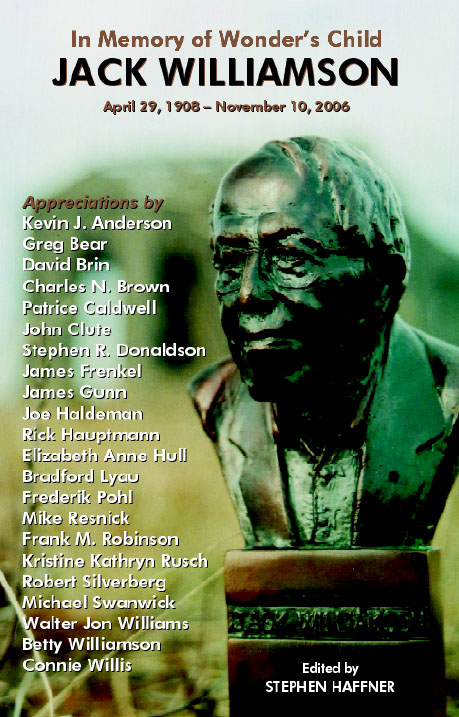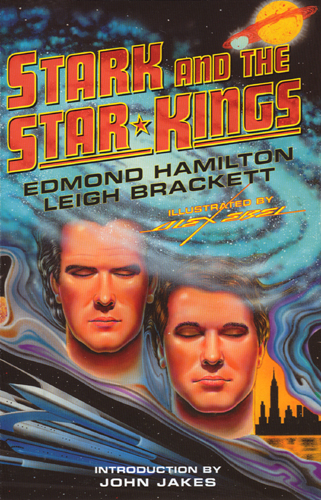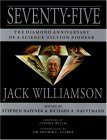|
NEXT
RELEASE

Gateway
to Paradise,
The Collected
Stories of Jack Williamson, Volume Six
|
FOR
CHARITY
In Memory of
Wonder's Child
Edited by
Stephen Haffner

|
|
Home
|
Authors
Brackett,
Leigh
Hamilton,
Edmond
Williamson, Jack
LEIGH
BRACKETT (December
7, 1915– March
18, 1978)
A
writer of science fiction, mystery novels and — best
known to the general public — Hollywood screenplays, most
notably The Big Sleep (1945), Rio Bravo (1959), The Long Goodbye (1973) and the first draft
of The Empire
Strikes Back (1980).
Brackett's first
published science fiction story was "Martian Quest", which appeared in
the February 1940 issue of Astounding Science
Fiction.
Her earliest years as a writer (1940-1942) were her most productive in
numbers of stories written; however, these works show a writer still
engaged in mastering her craft. The first of her science fiction
stories still attempt to emphasize a quasi-scientific angle, with
problems resolved by an appeal to the (usually imaginary) chemical,
biological, or physical laws of her invented worlds. As Brackett became
more comfortable as an author, this element receded and was replaced by
adventure stories with a strong touch of fantasy. Occasional stories
have social themes, such as "The Citadel of Lost Ships" (1943), which
considers the effects on the native cultures of alien worlds of Earth's
expanding trade empire.
Brackett's first
novel, No
Good from a Corpse, published in 1944,
was a hard-boiled mystery novel in the
tradition of Raymond Chandler. Hollywood director Howard
Hawks was so
impressed by this novel that he had his secretary call in "this guy
Brackett" to help William Faulkner write the script for The Big Sleep (1946). The film,
starring Humphrey Bogart and written by Leigh
Brackett, William Faulkner, and Jules
Furthman, is
considered one of the best movies ever made in the genre.
At the same time, Brackett's science fiction stories were becoming more
ambitious. Shadow
Over Mars
(1944) was her first novel-length science fiction story, and though
still somewhat rough-edged, marked the beginning of a new style,
strongly influenced by the characterization of the 1940s detective
story and film noir. Brackett's heroes from this period are tough,
two-fisted, semi-criminal, ill-fated adventurers. Shadow's Rick
Urquhart (reputedly modelled on Humphrey Bogart's shadier film
characters) is a ruthless, selfish space drifter, who just happens to
be caught in a web of political intrigue that accidentally places the
fate of Mars in his hands.
In 1946, the same year that Brackett married science fiction author Edmond Hamilton, Planet Stories published the
novella "Lorelei of the Red Mist". Brackett only finished the first
half before turning it over to Planet Stories' other acclaimed
author, Ray Bradbury, so that she could
leave to work on The Big Sleep.
"Lorelei"'s main character is an out-and-out criminal, a thief called
Hugh Starke. Though the story was well concluded by Bradbury, Brackett
seems to have felt that her ideas in this story were insufficiently
addressed, as she returns to them in later stories—particularly
"Enchantress of Venus" (1949).
Brackett
returned from her break from science-fiction writing,
caused by her cinematic endeavors, in 1948. From then on to 1951, she
produced a series of science fiction adventure stories that were
longer, more ambitious, and better written than her previous work. To
this period belong such classic representations of her planetary
settings as "The Moon that Vanished" and the novel-length Sea-Kings of Mars (1949), later
published as The
Sword of Rhiannon, a vivid description
of Mars before its oceans evaporated.
With "Queen of the Martian Catacombs" (1949), Brackett found for the
first time a character that she cared to return to. Brackett's Eric John Stark is sometimes
compared to Robert E. Howard's Conan, but is in many
respects closer to Edgar Rice Burroughs' Tarzan or Rudyard Kipling's Mowgli. Stark, an orphan
from Earth, is raised by the semi-sentient aboriginals of Mercury,
who are later killed by Earthmen. He is saved from the same fate by a
Terran official, who adopts Stark and becomes his mentor. When
threatened, however, Eric John Stark frequently reverts to the
primitive N'Chaka, the "man without a tribe" that he was on Mercury.
Thus, Stark is the archetypical modern man—a beast with a thin veneer
of civilization. From 1949 to 1951, Stark (whose name obviously echoes
that of the hero in "Lorelei") appeared in three tales, all published
in Planet
Stories; the
aforementioned "Queen", "Enchantress of
Venus", and finally "Black Amazon of Mars". With this last story
Brackett's period of writing high adventure ends.
Brackett's stories thereafter adopted a more elegiac tone. They no
longer celebrate the conflicts of frontier worlds, but lament the
passing away of civilizations. The stories now concentrate more upon
mood than on plot. The reflective, retrospective nature of these
stories is indicated in the titles: "The Last Days of Shandakor";
"Shannach — the Last"; "Last Call from Sector 9G". This last story was
published in the very last issue (Summer 1955) of Planet Stories, always Brackett's
most reliable market for science fiction. With the disappearance of Planet Stories and, later in 1955,
of Startling
Stories and Thrilling Wonder
Stories,
the market for Brackett's brand of story dried up, and the first phase
of her career as a science fiction author ended. A few other stories
trickled out over the next decade, and old stories were revised and
published as novels. A new production of this period was one of
Brackett's most critically acclaimed science fiction novels, The Long Tomorrow (1955). This novel
describes an agrarian, deeply technophobic society that develops after
a nuclear war.
But most of Brackett's writing after 1955 was for the more lucrative
film and television markets. In 1963 and 1964, she briefly returned to
her old Martian milieu with a pair of stories; "The Road to Sinharat"
can be regarded as an affectionate farewell to the world of "Queen of
the Martian Catacombs", while the other – with the intentionally
ridiculous title of "Purple Priestess of the Mad Moon" – borders on
parody.
After another hiatus of nearly a decade, Brackett returned to science
fiction in the seventies with the publication of The Ginger Star (1974), The Hounds of Skaith (1974), and The Reavers of Skaith (1976), collected as The Book of Skaith in 1976.
This trilogy brought Eric John Stark back for adventures upon the
extrasolar planet of Skaith (rather than his old haunts of Mars and
Venus). A fourth Stark novel was planned with Ballantine Books editor
Lester del Rey, but was abandoned (and no actual manuscript was begun)
when Brackett was offered the scipting duty for the sequel to Star Wars.
Most of Brackett's
science fiction can be characterized as space
opera or planetary romance. Almost all of her
planetary romances take place within a common invented universe, the Leigh Brackett Solar System,
which contains richly detailed fictional versions of the consensus Mars
and Venus of science fiction in the 1930s–1950s. Mars thus appears as a
marginally habitable desert world, populated by ancient, decadent, and
mostly humanoid races; Venus as a primitive, wet jungle planet,
occupied by vigorous, primitive tribes and reptilian monsters.
Brackett's Skaith combines elements of Brackett's other worlds with
fantasy elements.
The fact that the settings of Brackett's stories range from a
rocket-crowded interplanetary space to the superstitious backwaters of
primitive or decadent planets allows her a great deal of scope for
variation in style and subject matter. In a single story, Brackett can
veer from space opera to hard-boiled detective fiction to Western to
the borders of Celtic-inspired fantasy. Brackett cannot, therefore, be
easily classified as a sword-and-planet science fantasy
writer; though swords and spears may show up in the most primitive
regions of her planets, guns, blasters and electric-shock generators
are more common weapons.
Though the influence of Edgar Rice Burroughs
is apparent in Brackett's Mars stories, the differences between their
versions of Mars are great. Brackett's Mars is set firmly in a world of
interplanetary commerce and competition, and one of the most prominent
themes of Brackett's stories is the clash of planetary civilizations;
the stories both illustrate and criticize the effects of colonialism
on civilizations which are either older or younger than those of the
colonizers, and thus they have relevance to this day. Burroughs' heroes
set out to remake entire worlds according to their own codes;
Brackett's heroes (often anti-heroes) are at the mercy of trends and
movements far bigger than they are.
—adapted from the Wikipedia entry on Leigh
Brackett
back
EDMOND HAMILTON
(October 21, 1904 - February 1, 1977)
A was a popular
author of science fiction stories and novels during the mid-twentieth
century. Born in Youngstown,
Ohio, he was raised there and in nearby New Castle, Pennsylvania.
Something of a child prodigy, he graduated high school and started
college (Westminster College, New Wilmington,
Pennsylvania) at the age of 14–but washed out at 17.
His career
as a science fiction writer began with the publication of the story,
"The Monster God of Mamurth,"
which appeared in the August 1926 issue of the classic magazine of
alternative fiction, Weird Tales.
Hamilton quickly became a central member of the remarkable group of Weird
Tales writers assembled by editor Farnsworth Wright, that included
H. P. Lovecraft and Robert E. Howard. Hamilton would publish 79 works
of fiction in Weird Tales between 1926 and 1948, making him one
of the most prolific of the magazine's contributors (only Seabury Quinn
and August Derleth appeared more frequently). Hamilton became a friend
and associate of several Weird Tales veterans, including E.
Hoffmann Price and Otis Adelbert Kline; most notably, he struck up a
40-year friendship with close contemporary Jack Williamson, as
Williamson records in his 1984 autobiography Wonder's Child. In
the late 1930s Weird Tales
printed several striking fantasy tales by Hamilton, most notably "He
That Hath Wings" (July 1938), one of his most popular and
frequently-reprinted pieces.
Through the late 1920s and early '30s Hamilton wrote for all of the SF pulp magazines then publishing, and
contributed horror-thriller stories to various other magazines as well.
He was very popular as an author of space opera, a sub-genre he created along with E.E. "Doc"
Smith. His story "The Island of Unreason" (Wonder
Stories,
May 1933) won the first Jules Verne Prize as the best SF story of the
year (this was the first SF prize awarded by the votes of fans, a
precursor of the later Hugo Awards).
In the later 1930s, in response to the economic strictures of the Great
Depression,
he also wrote detective and crime stories. In the 1940s, Hamilton was
the primary force behind the "Captain Future" franchise,
an SF pulp designed for juvenile readers that won him many fans, but
diminished his reputation in later years when science fiction moved
away from its space-opera roots. Hamilton was always associated with an
extravagant, romantic, high-adventure style of SF, perhaps best
represented by his 1947 novel The Star Kings. As the SF field
grew more sophisticated, his brand of extreme adventure seemed ever
more quaint, corny, and dated.
In 1946
Hamilton began writing for DC Comics, specializing in stories for their
characters Superman and Batman.
One of his best known Superman stories was "Superman Under the Red Sun"
which appeared in Action Comics
#300 in 1963 and which has numerous elements in common with his novel City At
World's End (1951). He wrote other works for DC Comics,
including the short-lived science fiction series Chris KL-99 (in Strange Adventures), which was
loosely based on his Captain Future character. He retired from comics
in 1966.
On December
31, 1946, Hamilton married fellow science fiction author and screen writer Leigh Brackett. Afterward he
would produce some of his best work, including his novels The Star
of Life (1947), The Valley of Creation (1948), City at
World's End, and The Haunted Stars
(1960). In this more mature phase of his career, Hamilton moved away
from the romantic and fantastic elements of his earlier fiction to
create some unsentimental and realistic stories, such as "What's It
Like Out There?" (Thrilling Wonder Stories, Dec. 1952), his
single most frequently-reprinted and anthologized work.
Though
Hamilton and Leigh Brackett worked side by side for a
quarter-century, they rarely shared the task of authorship; their
single formal collaboration, Stark and the Star Kings, would
not appear in print until 2005.
Edmond Hamilton died in 1977 in Lancaster, California, of complications
following kidney surgery. A year after his death, Toei Animation in
Japan produced 52 animated episodes based on 13 of Hamilton's Captain
Future novels. This animated adaptation later played in Europe, winning
Hamilton a new and different
fan base than the one that had
acclaimed him half a century before.
—adapted from the Wikipedia entry on
Edmond Hamilton
back
JACK
WILLIAMSON (April 29, 1908–November 10, 2006)
John Stewart Williamson, who wrote as Jack Williamson
(and occasionally under the pseudonym Will
Stewart) was a U.S. writer
often referred to as the "Dean of Science Fiction"
Williamson was born April 29, 1908 in Bisbee, Arizona Territory, and spent his early
childhood in western Texas. In search of better pastures, his family
migrated to rural New Mexico in a
horse-drawn covered wagon in 1915. The
farming was difficult there and the family turned to ranching, which
they continue to this day.
Williamson received his Bachelor
of Arts and Master of Arts
degrees in English in the 1950s from Eastern
New Mexico University (ENMU) in Portales
(near the Texas panhandle), joining the faculty of that university in
1960. He remained affiliated with the school for the rest of his life.
In the late 1990s, he established a permanent trust to fund the
publication of El Portal, ENMU's journal of literature and art.
In the 1980s, he made a sizable donation of books and original
manuscripts to ENMU's library, which resulted in the formation of a
Special Collections department; the library now is home to the Jack
Williamson Science Fiction Library, which ENMU's website describes as
"one of the top science fiction collections in the world." In addition,
Williamson hosted the Jack Williamson Lectureship Series,
an annual panel discussion in which two science fiction authors were
invited to speak to attendees on a set topic. The Jack Williamson
Liberal Arts building houses the Mathematics, Art, and Languages &
Literature Departments of the university.
Williamson completed his Ph.D. in English literature at the University of Colorado
in Boulder, focused on H.G. Wells'
earlier works, demonstrating that Wells was not the naive optimist that
many believed him to be. In the field of science, Jack Williamson
coined the word terraforming in a
science-fiction story, "Collision Orbit," published in 1942 in Astounding
Science Fiction.
In the mid 1970s, Williamson was named a Grand Master of
Science Fiction by the Science Fiction Writers of
America. He was only the second person to receive this honor. The
first was Robert A. Heinlein.
After
retiring from teaching full-time in 1977, Williamson spent
some time concentrating on his writing, but after being named Professor
Emeritus by ENMU, he was coaxed back to co-teach two evening classes,
"Creative Writing" and "Fantasy and Science Fiction" (he pioneered the
latter at ENMU during his full-time professorship days). Williamson
continued to co-teach these two classes into the 21st century.
In November 2006, Williamson died at his home in Portales, New Mexico at age 98.
Despite his age, he had made an appearance at the Spring 2006 Jack
Williamson Lectureship and published a 320-page novel, The
Stonehenge Gate, in 2005.
—adapted
from the Wikipedia entry on Jack Williamson
back
|
HAFFNER PRESS
5005 Crooks Road • Suite 35
Royal Oak, MI 48073-1239
ph: 248-288-4765
info@haffnerpress.com
Copyright © 2008 Haffner Press. All Rights Reserved.
|
FEATURED ITEMS
Stark and the
Star Kings
by
Edmond Hamilton
&
Leigh Brackett

Seventy-Five: The Diamond Anniversary of a
Science FIction Pioneer--Jack Williamson
Edited by
Stephen Haffner
&
Richard A. Hauptmann

|
|



















